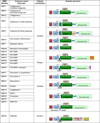Matrix metalloproteinases (MMPs) and tissue inhibitors of metalloproteinases (TIMPs): Positive and negative regulators in tumor cell adhesion
- PMID: 20470890
- PMCID: PMC2941566
- DOI: 10.1016/j.semcancer.2010.05.002
Matrix metalloproteinases (MMPs) and tissue inhibitors of metalloproteinases (TIMPs): Positive and negative regulators in tumor cell adhesion
Abstract
Cells adhere to one another and/or to matrices that surround them. Regulation of cell-cell (intercellular) and cell-matrix adhesion is tightly controlled in normal cells, however, defects in cell adhesion are common in the majority of human cancers. Multilateral communication among tumor cells with the extracellular matrix (ECM) and neighbor cells is accomplished through adhesion molecules, ECM components, proteolytic enzymes and their endogenous inhibitors. There is sufficient evidence to suggest that reduced adherence is a tumor cell property engaged during tumor progression. Tumor cells acquire the ability to change shape, detach and easily move through spaces disorganizing the normal tissue architecture. This property is due to changes in expression levels of adhesion molecules and/or due to elevated levels of secreted proteolytic enzymes, including matrix metalloproteinases (MMPs). Among other roles, MMPs degrade the ECM and, therefore, prepare the path for tumor cells to migrate, invade and spread to distant secondary areas, where they form metastasis. Tissue inhibitors of metalloproteinases or TIMPs control MMP activities and, therefore, minimize matrix degradation. Both MMPs and TIMPs are involved in tissue remodeling and decisively regulate tumor cell progression including tumor angiogenesis. In this review, we describe and discuss data that support the important role of MMPs and TIMPs in cancer cell adhesion and tumor progression.
Published by Elsevier Ltd.
Conflict of interest statement
The authors declare that there is no conflict of interest.
Figures


References
-
- Gumbiner BM. Cell adhesion: the molecular basis of tissue architecture and morphogenesis. Cell. 1996;84:345–357. - PubMed
-
- Brooks SA, Lomax-Browne HJ, Carter TM, Kinch CE, Hall DM. Molecular interactions in cancer cell metastasis. Acta Histochem. 2010;112:3–25. - PubMed
-
- Christofori G. New signals from the invasive front. Nature. 2006;441:444–450. - PubMed
Publication types
MeSH terms
Substances
Grants and funding
LinkOut - more resources
Full Text Sources
Other Literature Sources

